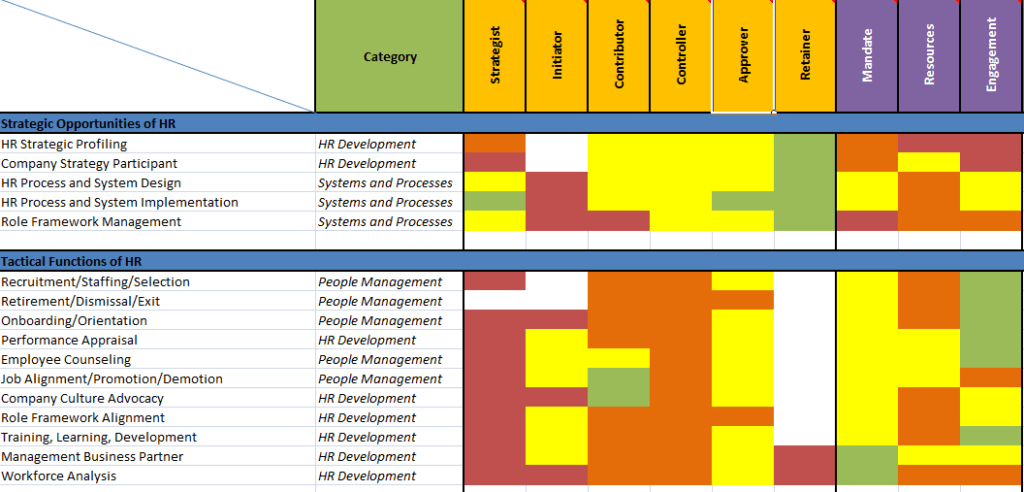Talented and trained employees, inspiring corporate and smooth processes are all hallmarks of a successful HR Development program.
But including HR into business strategy, especially in very large companies, can be a challenge. In many companies that have grown organically, change has been slow to accept Human Resources as a factor in their business strategy. While many other financial, legal and market circumstances are factored in, the Human element can end up being overlooked past the recruitment phase. Once a position is filled and the gears are turning, people change are at risk of turning from assets into spare parts.
Not only does this ignore the potential for growth of your most talented employees, it also means that changes in your business strategy are not adequately communicated and adjusted for among your employees. This can lead to sudden shifts and changes that appear to come out of nowhere, reorganizations that leave people reeling, and dissatisfied employees who seek appreciation and affirmation elsewhere.
Companies that have been restructured in a major way in the last decade or so usually have included Human Resources at least at the “C-level” in the form of a Chief Human Resources Officer, or CHRO. The role of the CHRO goes beyond that of a regular Head of HR, not just by being involved at a larger (sometimes global) scale, it also implies having the mandate, resources and drive to bring HR as a contributor to the strategy discussions as well as stand up for the requirements and benefits of a sound Human element in business strategy.
While businesses work to engage Human Resources elements into their strategy briefs, the HR leadership has a primary responsibility to ensure that the department itself fulfills its functional obligations and has a thorough understanding of the current state of the various processes and actions that HR is in charge of. After all, if the department does not have a solid grasp on all processes or lacks a critical decision-making element (mandate, resources or engagement), this shows that the required maturity is lacking to take part in discussions and decisions at this level.
To jump-start this self-reflection one of the options is to make an HR Functional Analysis where a compilation is made of all of the tasks that are required of HR, divided between the strategic, tactical and executive levels of decision making. Each of these tasks is mapped along their process lines, and the quality of involvement of HR is mapped, along with the department’s decision-making elements.
The source of information here should be varied, ranging from the opinions of decision makers and people involved in the process, the ranking given by people who are the beneficiaries of the process or action, and as many quantitative factors as possible regarding the HR department’s performance (such as % errors in administration, time to handle tasks, or satisfaction surveys).
There is no right or wrong way to set up this analysis, as long as it follows proper analytic principles. The core question to be answered is whether HR is in control and in a leadership position of its own critical processes, before participating in a higher level of decision making. Those elements which are considered below par (or worse yet, lacking entirely) would need to be shored up to ensure that HR maintains the perception of a credible and knowledgeable discussion partner.
An Excel template for such a Functional Analysis can be found here; changes are required to best fit the tasks and processes with the framework used in your organisation. For example, one organisation might see reward and compensation (bonus versus pay versus expense compensation) as a single process line, while others might separate out base salary from bonuses and recuperation of expenses. This list is not exhaustive, and is likely to change along with the major theories prevalent in modern HR; it also paints broad, philosophical strokes, to avoid becoming entrenched in country-specific systems of employment and tax law. Keeping the big picture will also be great practice for maintaining a level head in business-level decisions.
Along each line, mark the organisation’s compliance at each phase of a project or process using either a number or color valuation (see the Data tab) and you should be able to determine for your organisation whether there are any striking areas of improvement. Obviously, if you see whole columns that are mostly orange or red, you have found an area that might need restructuring or further in-depth analysis. If the “resources” column is consistently orange or red, it indicates that HR is understaffed or under budgeted, and becoming a strategic player requires being more frugal with resources and more clever with implementations.
Additionally, this template can also help you determine strategic weaknesses that you may find require specific attention or improvement. If you are new to HR and discover a gap in a process, you may find yourself on a scavenger hunt to find out how this is handled in reality, rather than on paper. You could find an ingenious efficient solution that may be used elsewhere to great effect as likely as you may discover a hand-made labor-intensive bypass of an official (automated) process that has remained invisible for years while its results quietly frustrated management.
HR Development is, by itself, a work in progress. At the start of each bid for a seat at the Executive table lies an uphill battle in “developing HR development”. Like Creatio Ex Nihilo, the first step is taken into a void, when the HR department and functionality needs to be expanded beyond its primary administrative functions. Showing initiative and leadership are both requirements and primary indicators of your HR department’s capability to drive business, rather than process.

